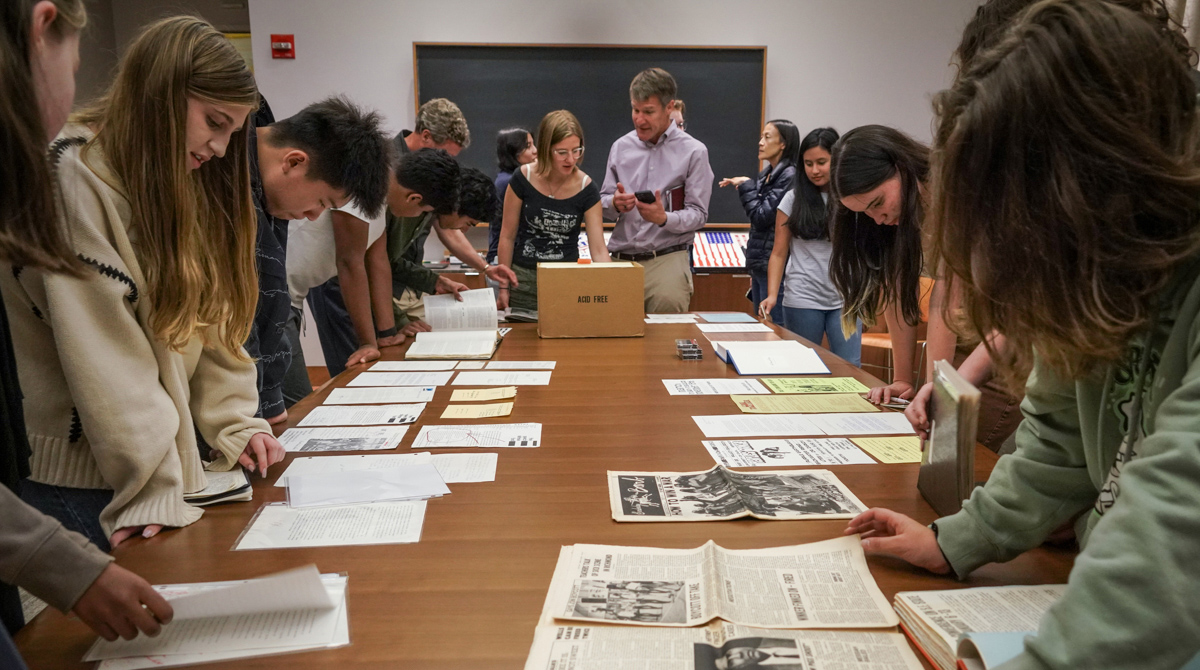
The first lesson of the day: Today’s lesson is not like other lessons.
It’s early afternoon on a Friday. The school year has just begun. The visitors, blending in on the UC Berkeley campus with their hoodies and T-shirts, have just finished lunch. By request, they wash their hands — the first clue that today would be different — and scuttle into a room at The Bancroft Library, ready to learn.
The 10th graders, enrolled in a course on the First Amendment at San Jose’s Hillbrook School, huddle around a long table. Sprawled in front of them is a colorful array of artifacts to explore, a hand-picked assortment of letters, interviews, photographs, flyers, and other vestiges of history. (Yes, touching the materials is OK — that’s what the hand-washing was for.)
For the next 45 minutes, the 21 students travel through time.
The destination? Berkeley in the 1960s. The occasion? The Free Speech Movement.
Browsing the materials at the head of the table, Piper Silver notices decades-old sign-up sheets, which students had filled out by hand to lend their time and skills to the cause. (“It’s like a Google Form,” Silver muses.)
“One of them was 17 years old — not even an adult, not even in college yet — participating in a movement,” Silver notes of one of the respondents. “They’re, like, our age.”
Edwin Sanchez is drawn to a letter from a father whose son was arrested for participating in civil disobedience.
“It kind of showed that the parent still had empathy and supported his son through it,” Sanchez says. “He said that his son had the guts to be able to stand up for what he believed in.”
Bit by bit, the materials chip away at the imposing wall separating past and present, allowing the high schoolers to commune across time with students like them, just a few years older, and generations removed.
Through primary sources such as these, the UC Berkeley Library is keeping alive the memory of the Free Speech Movement — its struggles, its spirited successes, and the students at its heart — 60 years after it began. By weaving these threads of history into its collections and spaces, the Library offers students and scholars, and time travelers of all kinds, snapshots of the past, and lessons for the future.
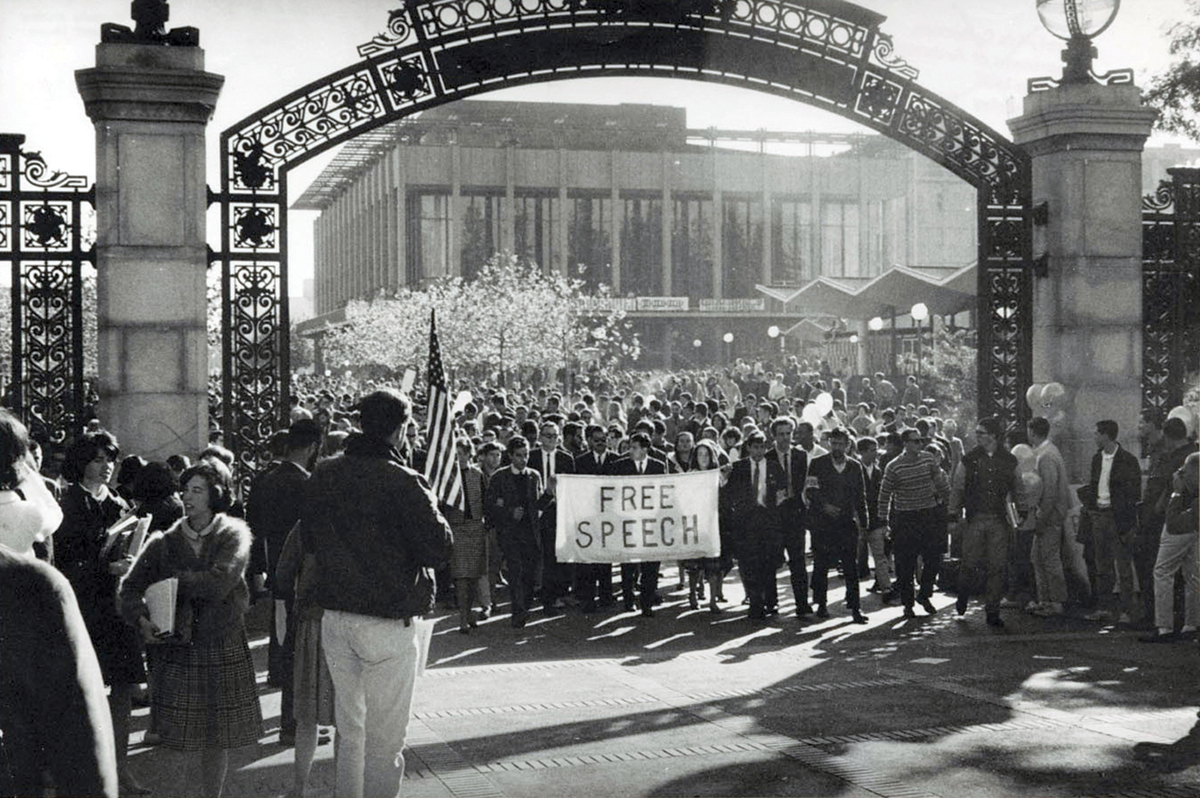
Voices of the movement
If UC Berkeley were a city unto itself, Sproul Plaza would be its town square, a bustling blur of people and ideas. On a given day, you might notice Sisyphean skateboarders trying new tricks, rows of dancers working out their routines, and taiko drummers providing the pulsing soundtrack.
You might also notice a sight that’s now taken for granted: people, with signs, slogans, or flyers, rallying around a range of political causes. It’s hard to imagine now, but it wasn’t always that way.
What changed? To answer that, you have to go back to Oct. 1, 1964, the date circled on the calendar as the beginning of the Free Speech Movement.
That morning, as the oft-told story goes, Jack Weinberg set up a table on Sproul Plaza. The newly minted UC Berkeley graduate was proffering literature on behalf of the Congress of Racial Equality, or CORE. The problem? That sort of thing — political activity on campus — was strictly forbidden.
University officials and a police officer approached Weinberg, warning him that he was running afoul of campus rules. After refusing to leave or identify himself, Weinberg was placed under arrest, and was carried to the police car parked on the plaza.
Lisa Rubens ’67, M.C.P. ’73, Ph.D ’00, a sophomore at Berkeley at the time, was coming out of class with her boyfriend when she witnessed the scene.
“We saw the phenomenon,” Rubens says. “We saw the expanding circle around the car.”
A voice from the gathering crowd yelled, “Sit down!” Soon, the vehicle was surrounded by hundreds of seated students.
“We spent the rest of the afternoon there,” Rubens says.
For the next 32 hours, Weinberg sat in the cruiser, which had become a pale island in a sea of people. Mario Savio, 21, was the first to address the audience, turning the car’s roof into a makeshift soapbox.
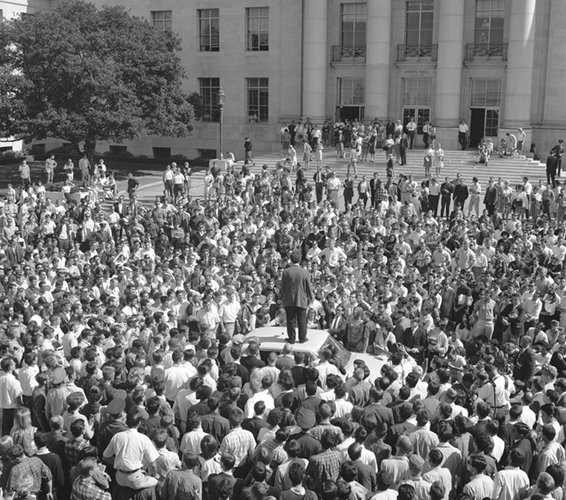

Savio, who had enrolled at UC Berkeley the previous year, had spent the summer of 1964, “Freedom Summer,” in Mississippi, helping boost voter registration among Black residents. Growing up, Savio had been an exceptionally bright student. He had also been teased for his debilitating stutter, which melted away in front of the crowd.
“There was something very tender, something pained, about him,” Rubens recalls.
Savio’s passion and eloquence — his precise use of language to cut through complexities, define the problems, and galvanize students to join the struggle — would make him the figurehead of the Free Speech Movement.
Rubens, who had never been involved in a mass movement up to that point, became a “foot soldier” for the cause, participating in demonstrations and noontime meetings.
“It exploded my mind,” she says of the movement. “And it exploded my world.”
Decades later, as a historian and interviewer in The Bancroft Library’s Oral History Center, Rubens began to chronicle that moment in history for the Free Speech Movement Oral History Project. Comprising nearly 50 interviews, the project immortalizes the stories and voices of the people who were there.
For the project, Rubens interviewed lawyers who defended more than 800 student activists who took part in the December occupation of Sproul Hall, which led to the largest mass arrest in the state’s history up to that point. She talked to Michael Lerner, a graduate student who led a Hanukkah service, complete with candles and menorah, during the Sproul Hall sit-in. In a heartfelt conversation, Charlie Powell revealed his struggle to find firm footing as the president of Berkeley’s student government amid the rising influence of the movement. In another interview, Ronald Takaki, a graduate student who took up the cause, talked about how the movement changed his life. Takaki went on to become a pioneering scholar of race relations, and taught the University of California’s first Black history course.
“My scholarship — my writing — is a moral, political passion, and that passion was born in the throes of the Free Speech Movement,” Takaki says in his interview.
And he was not alone.
“So many spoke of the movement as being formative in their lives for how they looked at the world,” Rubens says.

Close-up on a cause
Along with the words of witnesses and participants, Bancroft holds vivid visual reminders of the movement, including from the day the fuse was lit, and freeze-frames of the flashpoints that followed.
In one iconic image, students carry the banner of free speech under Sather Gate. Another photo shows folk hero Joan Baez, with the strum of a guitar, bringing the struggle at Berkeley into the broader protest movement. A series of stills documents the activities of Dec. 7, from the campuswide meeting at the Greek Theatre — at which Savio was dragged offstage by police officers — to the ensuing protest at Sproul Plaza, which drew about 10,000 students, including some who perched on the surrounding roofs.
All told, Bancroft holds around 1,500 photographs documenting the movement, many of which are available for anyone to see online on the Library’s Digital Collections portal.
When Christine Hult-Lewis, Bancroft’s pictorial curator, was an undergraduate at Berkeley in the ’80s, anti-apartheid protests, and calls for the university to divest from South African companies, swept the campus. You can draw a direct line from that cause to the Free Speech Movement, she says.
The Free Speech Movement, like the anti-apartheid activism that would follow, resulted in victory — a vote by Berkeley’s Academic Senate to lift restrictions on the content of speech on campus.
The movement went on to inspire students fighting for change across the country. And today, UC Berkeley’s reputation for activism, forged in the flames of the ’60s, endures.
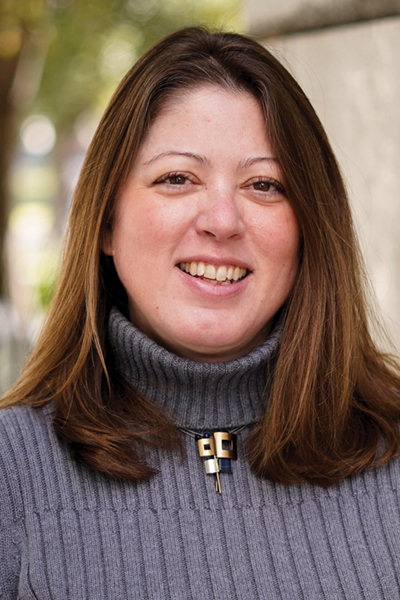
“I think young people can see themselves (in these photographs),” Hult-Lewis says. “These are not abstract ideas. These are real people.”
Steps from Bancroft, Moffitt Library’s Free Speech Movement Café is a living monument, splashed with photographs from the Library’s collections of students championing the cause. The cafe was made possible through the generosity of Stephen M. Silberstein ’64, M.L.S. ’77, whose support has also helped the Library preserve the history of the movement, and bolster its collections and facilities.
“Seeing these pictures gives you a sense of the movement, of people coming together to speak up about broader societal issues,” says Elizabeth Dupuis, senior associate university librarian. “I hope that people, and students specifically, get the idea that they can improve their conditions — that they can shape the world around them.”
“The university is a training ground for people to learn to be informed and engaged citizens,” Dupuis adds. “And the Library plays a part in that.”
History, revisited
For his research on the Free Speech Movement, journalist Seth Rosenfeld ’81 turned his attention to some of the people at the heart of the movement, and those who resisted it.
Rosenfeld researched the saga over the course of more than three decades, starting as a reporter for The Daily Californian, UC Berkeley’s student newspaper, and culminating in the riveting and revealing 2012 book Subversives: The FBI’s War on Student Radicals, and Reagan’s Rise to Power. Drawing on more than 300,000 pages of confidential FBI records, obtained through a series of Freedom of Information Act lawsuits, Rosenfeld tells the story of how the FBI used its long tendrils to secretly disrupt and discredit the student movement.
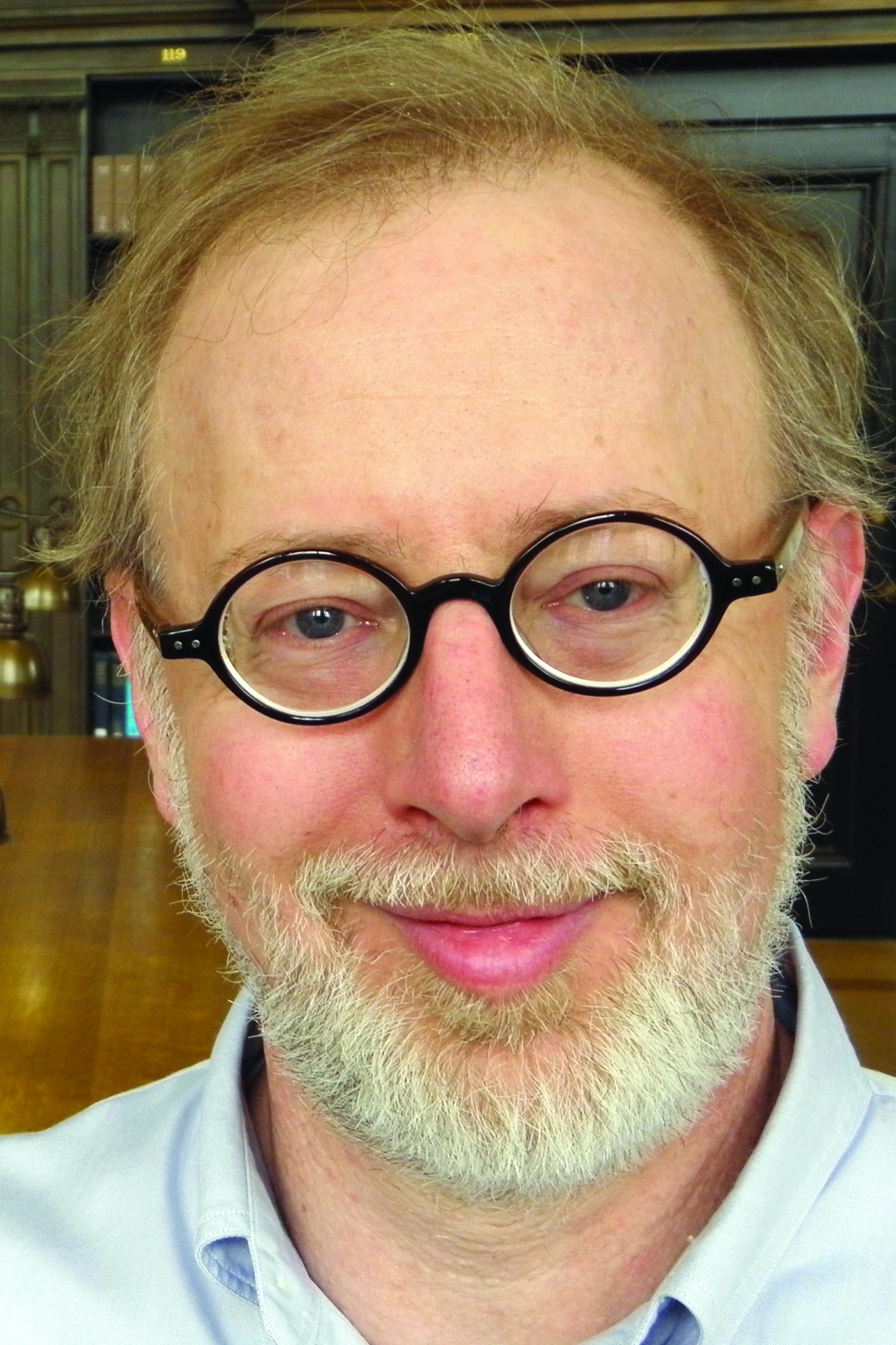
In the book, Rosenfeld chronicles the clashing social and political forces of the time: the Free Speech Movement, represented by Mario Savio and others rebelling against the status quo; the growing conservative movement, embodied by Ronald Reagan, whose hard-line response to the free speech struggle at Berkeley helped catapult him onto the political stage; and the liberal establishment, personified by UC President Clark Kerr, “the man in the middle.”
UC Berkeley’s libraries were “instrumental” to Rosenfeld’s research, he says.
At the Newspapers & Microforms Library, a cavernous room in the basement of Doe Library, Rosenfeld read accounts in mainstream and underground newspapers, which would have been hard to find elsewhere. In the government documents collection, formerly located on Doe’s third floor, he found congressional reports on intelligence agency abuses. And at the Institute of Governmental Studies Library, he immersed himself in reports on California politics, providing context for the historical moment.
Rosenfeld consulted a range of materials at The Bancroft Library, including Kerr’s papers, which reveal insights into the personality and ambitions of the future UC Berkeley chancellor and UC president. In a letter to his father from 1932, the year he graduated from Swarthmore College, Kerr expressed a change of heart about his career path. “I would never be satisfied in business,” he writes. “It may not seem advisable — but I would like to study and travel as widely as possible and prepare for some work along the line of lecturing and teaching and working for a better social and economic and political order.”
Other materials Rosenfeld consulted at Bancroft include Savio’s high school and college transcripts, and letters from Savio to his girlfriend, Cheri Stevenson, providing a window into his civil rights work in Mississippi against the backdrop of violence and intimidation. Rosenfeld also relied upon Bancroft’s oral histories, including interviews with Reagan.
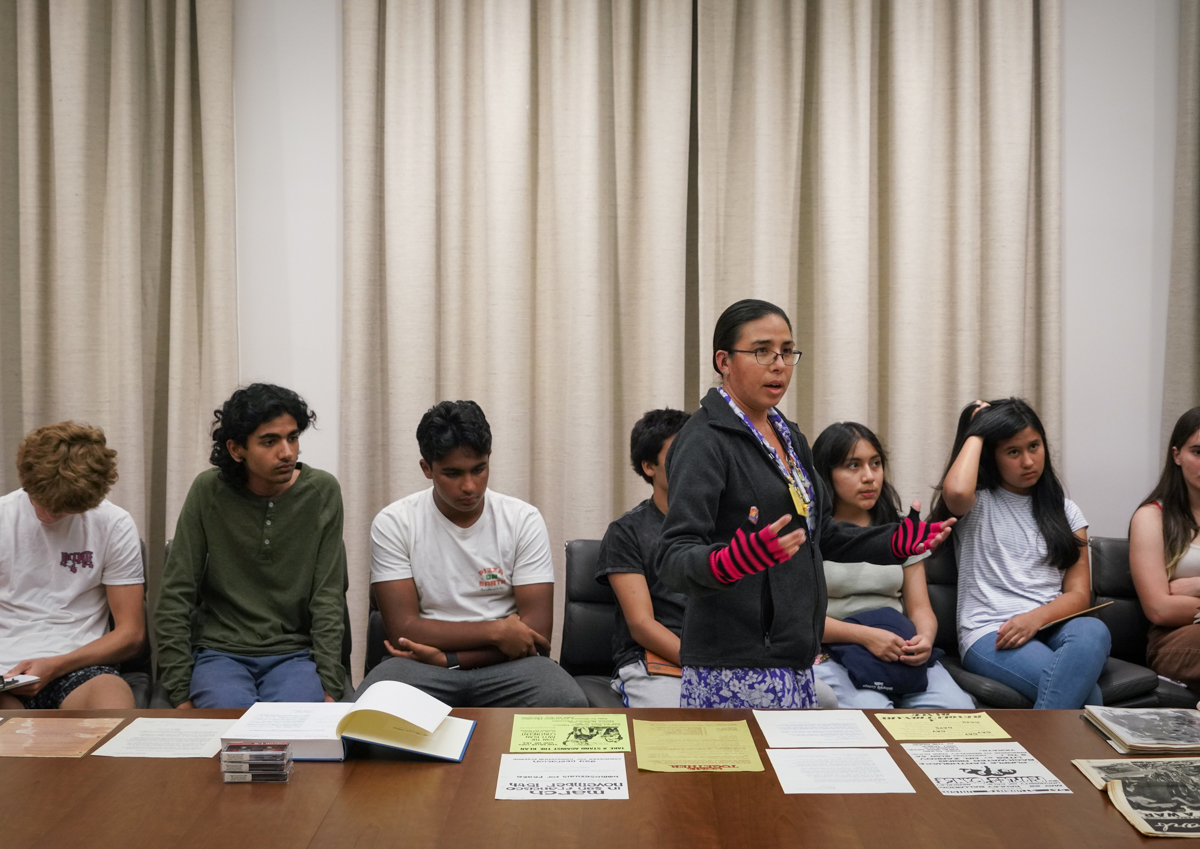
Taken together, these materials are also invaluable to future researchers looking for new ways to examine the past, refusing to let it gather dust behind closed doors.
“Some of the initial participants and eyewitnesses are still around, but many are not, so what we have left is what they left behind,” Hult-Lewis says. “Having these original primary sources can help answer some of the questions that haven’t yet been thought of, and the theses that have yet to be proven.”
We owe a debt of gratitude to the people with the foresight to recognize the value of the materials in the first place, says Lee Anne Titangos, Bancroft’s information and instruction specialist, who guided the class of high schoolers during their field trip in time. During the protest movements of the ’60s and ’70s, librarians would venture out to gather flyers circulating on Sproul Plaza, with the idea that they would have research value someday, she says.
“You have to thank the librarians … who had the thinking that you have to collect all these,” Titangos says. “You can’t let it all go away.”
The Free Speech Movement had far-reaching consequences: It allowed students to speak up about events that were unfolding around them — from civil rights to presidential elections to the Vietnam War.
But the story of the movement also strikes at the heart of what it means to be a university.
“The university is a place where people are supposed to question reality,” Rosenfeld says. “They’re supposed to look at things with fresh eyes and to question and learn, … and that naturally leads to debate and sometimes conflict.”
“So it makes sense that you would have protests and debate on campus,” he continues. “But I think what the Free Speech Movement reminds us is that it’s important to be sure everybody has a voice.”